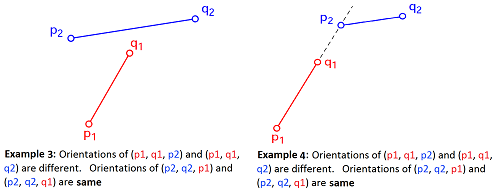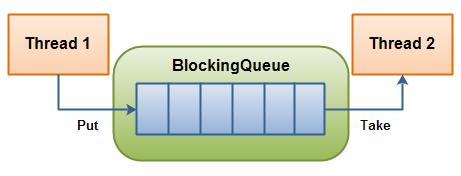Question
Given two line segments (p1, q1) and (p2, q2), check if 2 line segments intersect.
Orientation
Considering 3 pointer, orientation can be:
- counterclockwise
- clockwise
- colinear (not considering direction)

Note that orientation only tells the order and sequence relationship of 3 points. It tells nothing about intersection.
Intersection
Considering 2 line segments: (p1,q1) and (p2,q2).
Case 1: general
Two line segment intersect if BOTH the 2 conditions hold:
- (p1, q1, p2) and (p1, q1, q2) have different orientations and
- (p2, q2, p1) and (p2, q2, q1) have different orientations


Case 2: special
The speical case is: what if all 4 pointers (p1, q1, p2, q2) are all on the same line!!! Well, this definitely can happen.
If so, check if the values of x-axis and y-axis intersect. I.e. the below 2 cases:

Code
Translated from G4G:
public boolean intersect(Pair p1, Pair q1, Pair p2, Pair q2) {
int o1 = orientation(p1, q1, p2);
int o2 = orientation(p1, q1, q2);
int o3 = orientation(p2, q2, p1);
int o4 = orientation(p2, q2, q1);
// General case
if (o1 != o2 && o3 != o4) {
// 2 lines intersect
return true;
}
// Special Cases
Segment seg1 = new Segment(p1, q1);
Segment seg2 = new Segment(p2, q2);
// p1, q1 and p2 are colinear and p2 lies on segment p1q1
if (o1 == 0 && onSegment(seg1, p2))
return true;
// p1, q1 and p2 are colinear and q2 lies on segment p1q1
if (o2 == 0 && onSegment(seg1, q2))
return true;
// p2, q2 and p1 are colinear and p1 lies on segment p2q2
if (o3 == 0 && onSegment(seg2, p1))
return true;
// p2, q2 and q1 are colinear and q1 lies on segment p2q2
if (o4 == 0 && onSegment(seg2, q1))
return true;
return false; // Doesn't fall in any of the above cases
}
private boolean onSegment(Segment seg, Pair q) {
// check if q lies on line segment seg(p1, p2)
if (q.x <= Math.max(seg.p1.x, seg.p2.x)
&& q.x >= Math.min(seg.p1.x, seg.p2.x)
&& q.y <= Math.max(seg.p1.y, seg.p2.y)
&& q.y >= Math.min(seg.p1.y, seg.p2.y))
return true;
return false;
}
private int orientation(Pair first, Pair second, Pair third) {
int val = (second.y - first.y) * (third.x - second.x)
- (second.x - first.x) * (third.y - second.y);
if (val == 0) {
// colinear
return 0;
} else {
// clock or counterclock wise (1 or -1)
return val / Math.abs(val);
}
}
class Segment {
Pair p1;
Pair p2;
public Segment(Pair p1, Pair p2) {
this.p1 = p1;
this.p2 = p2;
}
}
